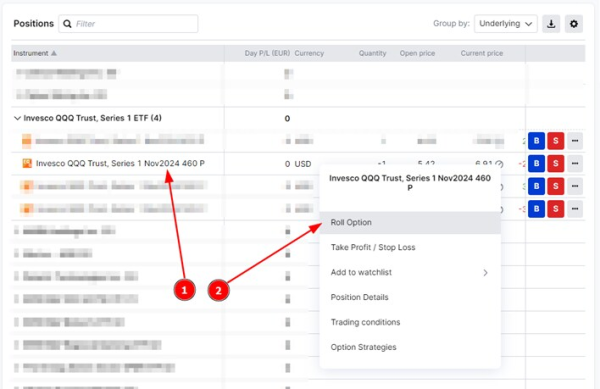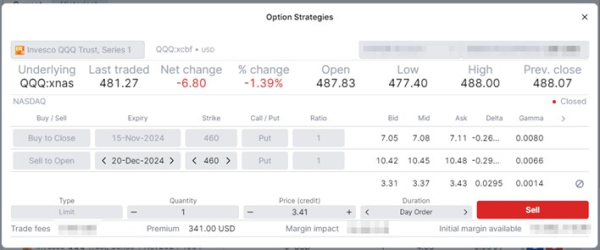Smart Investor: rolling options: a strategy for managing risk and extending profit potential
Options are complex, high-risk products and require knowledge, investment experience and, in many applications, high risk acceptance. We recommend that before you invest in options, you inform yourself well about the operation and risks.
Rolling options: a strategy for managing risk and extending profit potential
In the ever-changing landscape of options trading, “rolling” an option is a common yet often misunderstood tactic. Whether you're new to options or a seasoned trader, understanding how to roll options effectively can help you manage risk, secure profits, and extend your market exposure. In this article, we’ll explore what rolling an option entails, the various strategies involved, and why this technique is a valuable part of any trader’s toolkit.
What does it mean to roll an option?
At its core, rolling an option means closing an existing option position and opening a new one, typically with a different expiration date or strike price. This action allows traders to maintain their exposure to the market while adjusting the terms of their position. It’s essentially a tactical move, designed to adapt to changing market conditions without fully exiting the trade.
As discussed in the Option Talk podcast, rolling involves “substituting one position with another.” This process is executed within the same order ticket—closing the current position while simultaneously opening a new one. Whether you're adjusting a bullish, bearish, or neutral strategy, rolling gives you the flexibility to recalibrate your approach. Listen to the full episode here.
How to Initiate a roll in your trading platform
You can initiate a roll option by right-clicking on a position in your positions list. This action opens a context menu where you can select the “Roll Option” feature, as shown in the screenshot below:


These two simple steps are crucial for initiating and configuring a rolling strategy based on your market outlook.
The mechanics of rolling: when and why to do it
There are several reasons a trader might choose to roll an option, and these generally fall into two categories: offensive and defensive rolls. Understanding the difference between these approaches can help you make better decisions when market dynamics shift.
- Offensive rolls: locking in gains while staying invested
An offensive roll occurs when your option position is performing well, and you want to continue participating in the market’s potential upside. Let’s say you’re holding a long call option on a stock like NVIDIA, and the stock has surged since you bought it. You’ve made a profit on your current call, but you believe there’s still more room for the stock to run.
Instead of simply closing the position and taking your profits, you could roll the call. This means selling your current option (to lock in the profit) and buying another call with a later expiration date or a higher strike price. By doing this, you maintain a bullish stance while adjusting the position to suit your outlook on the stock’s future.
“You’re protecting your profit because you took your profit in the call you sold, but you still have a bullish view.” Rolling in this manner allows traders to capture more potential gains without the need for additional investment, depending on how the new position is structured.
- Defensive rolls: mitigating losses and buying time
On the other hand, defensive rolls come into play when a position isn’t moving in the desired direction. For example, imagine you’ve sold a put on a stock, expecting it to remain stable or rise. However, the stock has started to decline, and you’re now facing the possibility of assignment (having to purchase the stock at the strike price).
In this case, you could roll the put by buying back the current contract and selling a new one at a lower strike price with a later expiration date. This “down and out” adjustment gives you more time for the stock to recover, while reducing your risk of assignment. This type of roll is typically used to “postpone the loss,” giving the trade a second chance to succeed.
While this can be an effective strategy, it’s not without risks. Continually rolling a losing position can sometimes exacerbate losses, especially if the market continues to move against you. It’s important to avoid using defensive rolls simply as a way to delay taking necessary losses.
Rolling covered calls: a key strategy for income and flexibility
Rolling covered calls is a particularly popular strategy for traders and investors who hold long positions in stocks and want to generate additional income or adjust their exposure. A covered call involves selling call options against a stock position you already own. This is a conservative strategy that generates income from the premium received for selling the call, while still allowing some upside potential if the stock price appreciates.
Why roll a covered call?
There are several reasons why an investor might choose to roll a covered call:
- Protect against assignment: if the stock price rises above the strike price of the sold call, the investor may face assignment and be forced to sell their shares. By rolling the call up and out—buying back the existing call and selling a new one with a higher strike and later expiration—the investor can avoid assignment while maintaining their position in the stock.
- Generate additional income: rolling the call to a new strike price and expiration date can generate additional premium income. This can be particularly useful if the original call is nearing expiration, and the investor wants to continue the strategy of generating income from the stock position.
- Adjust market exposure: if the investor’s outlook on the stock has changed (e.g., they now expect a slower rate of appreciation), they might roll the call to a lower strike price to capture more premium, or to a higher strike price if they believe there’s greater upside potential.
Example of rolling a covered call
Let’s consider a practical example:
Imagine you own 100 shares of ABC Corp, currently trading at $100 per share. You initially sold a covered call with a strike price of $105, expiring in two weeks, and collected a $2 premium per share. If ABC rises to $107 as expiration approaches, your call is in the money, and you’re at risk of having to sell your shares at $105.
To avoid this, you could roll the call by buying back the original option and selling a new call with a $110 strike price and an expiration date two months out. This action accomplishes several things:
- Protects against assignment: by moving the strike price higher, you avoid being forced to sell your shares at $105.
- Allows more upside: the new $110 strike price allows you to participate in further appreciation of ABC’s stock.
- Generates additional income: the longer expiration date and higher strike price mean you can still collect a decent premium, perhaps even more than the original $2.
This is a common strategy for investors who want to hold onto their stock positions while continuing to generate income.
When not to roll a covered call
While rolling covered calls can be advantageous, it’s not always the best course of action. Here are some scenarios where rolling might not make sense:
- Changing market outlook: if you no longer believe in the stock’s growth potential or expect it to decline, it may be better to close the position entirely rather than rolling.
- Cost of rolling: if the cost of buying back the original call is too high relative to the new premium you can receive, rolling may not be worthwhile.
Key considerations when rolling options
Rolling options is not a guaranteed way to avoid losses or guarantee profits. Timing is critical. “If you wait too long, your rolling options become limited, especially with strikes and expiration dates.” It’s also important to have a clear outlook on the underlying asset. Rolling just to delay losses, without a solid view of the stock or index's future, can lead to larger losses in the long run.
Should you always roll?
Not necessarily. While rolling is a useful tool, it is not always the best course of action. Sometimes it’s better to take your profits or cut your losses. Rolling should be done with a clear strategy in mind, whether it's to extend profits or manage risk.
Final thoughts
Rolling options, especially covered calls, is a sophisticated strategy that can help traders extend profits or mitigate losses. However, it requires careful planning and a good understanding of market dynamics. Whether you're making an offensive move to capitalize on future potential or a defensive one to manage risk, rolling can be a flexible addition to your trading toolkit.
As with any options strategy, rolling requires both discipline and flexibility. When used correctly, it can be a powerful way to maintain your market exposure while adapting to changing conditions. Just remember, rolling is not a foolproof way to escape risk—sometimes, the best option is to cut your losses and move on.| Check out these guides and case studies: |
|---|
| In-depth guide to using long-term options for strategic portfolio management Our specialized resource designed to learn you strategically manage profits and reduce reliance on single (or few) positions within your portfolio using long-term options. This guide is crafted to assist you in understanding and applying long-term options to diversify investments and secure gains while maintaining market exposure. |
| Case study: using covered calls to enhance portfolio performance This case study delves into the covered call strategy, where an investor holds a stock and sells call options to generate premium income. The approach offers a balanced method for generating income and managing risk, with protection against minor declines and capped potential gains. |
| Case study: using protective puts to manage risk This analysis examines the protective put strategy, where an investor owns a stock and buys put options to safeguard against significant declines. Despite the cost of the premium, this approach offers peace of mind and financial protection, making it ideal for risk-averse investors. |
| Case study: using cash-secured puts to acquire stocks at a discount and generate income This review investigates the cash-secured put strategy, where an investor sells put options while holding enough cash to buy the stock if exercised. This method balances income generation with the potential to acquire stocks at a lower cost, appealing to cautious investors. |
| Case study: using collars to balance risk and reward This study focuses on the collar strategy, where an investor owns a stock, buys protective puts, and sells call options to balance risk and reward. This cost-neutral approach, achieved by offsetting the cost of puts with the premiums from calls, provides a safety net and additional income, making it suitable for cautious investors. |
| Previous "Investing with options" articles |
|---|
|
| "Saxo Options Talk" podcast |
|
| Other related articles |
|
| Why options strategies belong in every trader's toolbox |
| Understanding and calculating the expected move of a stock ETF index |
| Understanding Delta - a key guide for Investors and Traders |
|
Options are complex, high-risk products and require knowledge, investment experience and, in many applications, high risk acceptance. We recommend that before you invest in options, you inform yourself well about the operation and risks. In Saxo Bank's Terms of Use you will find more information on this in the Important Information Options, Futures, Margin and Deficit Procedure. You can also consult the Essential Information Document of the option you want to invest in on Saxo Bank's website.